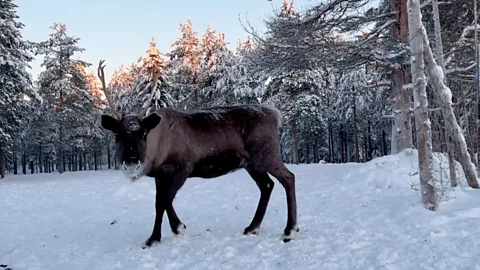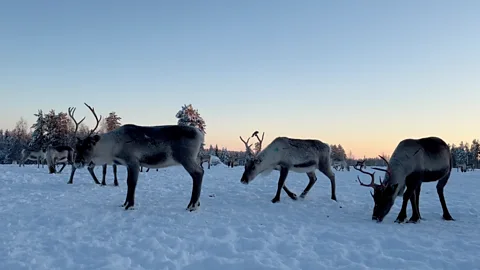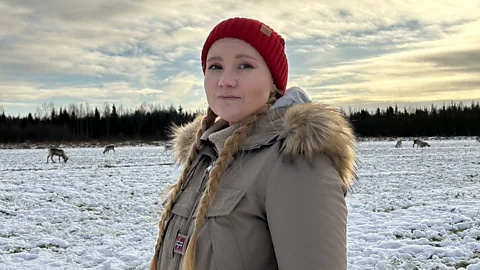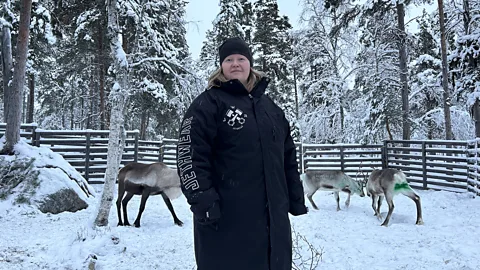How reindeer help fight climate change
 Erika Benke
Erika BenkeReindeer in Lapland have a number of important jobs this time of year – including helping the climate. By gobbling up shrubs, they help increase the reflectivity of snow and ice.
It's just after lunchtime, and darkness is already falling. Tiia Jeremejeff, a reindeer herder in northern Finland, jumps on a snowmobile to go and feed her family's herd, who are kept in a large enclosure in the winter. Her breath freezes almost instantly in the bitter cold – it's -15C (5F) here in Kierinki, 110km (68 miles) north of the Arctic Circle. There is a thick cover of snow in the forest, some 20cm (7.9in) deep.
"It's not easy, being a reindeer herder," says Jeremejeff, a woman of Sami descent whose livelihood and culture is tightly intertwined with reindeer-herding. "It's a harsh climate and we have to go out and feed them no matter how cold it gets."
Now, emerging evidence suggests reindeer may play a fundamental role in helping to preserve this entire ecosystem, including the snow cover, the open forest with its low-growing berry bushes, mosses and lichen – an organism formed by a close association of fungi and algae – and even the cold winter climate. Research suggests that grazing reindeer may in fact help to fight some of the effects of climate change in the Arctic, which is warming four times faster than the rest of the planet.
Sign up to Future Earth
Sign up to the Future Earth newsletter to get essential climate news and hopeful developments in your inbox every Tuesday from Carl Nasman. This email is currently available to non-UK readers. In the UK? Sign up for newsletters here.
Reindeer herding provides an income for more than 20 different indigenous communities in the Arctic. In total, about 100,000 people are involved in herding about 2.5 million domesticated reindeer in nine countries. Traditionally, indigenous communities have also used reindeer for transport, clothing and food. In the warmer months, the reindeer roam freely and feed on lichen and other plants, trampling the ground as they go. In the process, they prevent the growth of woody shrubs.
Called "shrubification", the growth of taller, woodier plants happens as an open landscape gradually transforms into a forest. Shrub and forest cover may generally sound desirable, but in the case of the Arctic landscape, it could erase an ancient ecosystem characterised by open forests, known as boreal forests, and the treeless Arctic tundra. Shrubification may also worsen the impact of climate change, as research suggests that shrubs trap heat that thaw the permafrost and warm up the tundra.
Research shows that global warming is in fact accelerating the shrubification of the Arctic, as the warmer, longer growing seasons speed up plant growth. This could lead to a cycle of more shrubs, more heat, and even more shrubs. Reindeer help slow down this process and the greening of the tundra by eating and trampling on plants. A study analysing satellite images of the shrub cover in the Yamal Peninsula in north-west Siberia found that vegetation in the area remained stable where there was a 75% increase in the reindeer population between 1986 and 2016, despite increasing summer temperatures.
The authors of the report say reindeer grazing in the Yamal Peninsula appears to have compensated for the effects of climate change. It has also helped preserve the tundra habitat so native species such as mosses, lichen and low-growing willows can continue to thrive.
Reindeer to the rescue
Jeremejeff and other reindeer herders in Lapland have seen this first hand.
"Reindeer eat lichen and other plants. They also trample on them so they make sure the vegetation is not too thick, and that keeps the ground colder," says Jeremejeff. "Thick vegetation on the ground would trap a lot of heat. If there are no leaves and grasses, the ground gets more frozen, and it freezes earlier in the winter."
Tiina Sanila-Aikio is also a Sami reindeer herder and the former president of Finland's Sami Parliament. Her reindeer roam free throughout the year in the forests around Lake Inari in the far north of Finland. She says that reindeer husbandry is the answer for maintaining open landscapes in both the tundra and the boreal forest, despite the challenges posed by climate change.
"The forest is quite open and wide here. That's because of the reindeer," she says. "If we didn't have them, the view would be totally different. As it gets warmer, everything grows much faster. We need reindeer to keep the forest open."
 Erika Benke
Erika BenkeScientists have also studied whether reindeer affect a landscape's carbon emissions. In one study, they measured the CO2 levels inside and outside reindeer enclosures in boreal forests to establish if the undergrowth acts as a carbon sink or a carbon source. One theory is that shrub growth could lead to greater CO2 emissions as it generates more biomass, or rotting plant matter. The undergrowth, which consists largely of lichen, moss and low-growing lingonberry and blueberry bushes, is thought to produce less decomposing biomass, since the plants are smaller.
CARBON COUNT
The emissions from travel it took to report this story were 80kg CO2. The digital emissions from this story are an estimated 1.2g to 3.6g CO2 per page view. Find out more about how we calculated this figure here.
For the last four years, Noora Kantola, a researcher at the University of Oulu in northern Finland, has been studying how reindeer grazing and changes in snow depth affect the release and uptake of CO2 in the undergrowth in two forests in northern Finland. She says that the impact of grazing and changing snow depth on CO2 emissions could have an effect over very long periods. Data she is currently analysing suggests that excluding reindeer for 20 years may not impact CO2 release, but exclusion for 50 years may have an impact.
"It's a preliminary finding but it appears that carbon release from the undergrowth may interact with snow depth when reindeer had been excluded for several decades in an area in the far north if Finland," Kantola says. "So it seems that reindeer grazing down the vegetation on the forest floor could help reduce carbon release to some extent under changing winter climate in a boreal forest as well. There's less biomass to decompose [when reindeers are present] which could further reduce CO2 emissions."
 Erika Benke
Erika BenkeThe way reindeer graze is also having an impact on the albedo effect, which is the capacity of the snow and ice to reflect heat. Research suggests that shrubs speed up the snowmelt in the spring, as they trap heat and generate warmth through their dark twigs extending above the snow. By removing shrubs, reindeer may help slow the melt, preserving the snow cover and its important sunlight-reflecting, cooling effect. This may be especially important in the open tundra, where there are no trees to shade and cool the snow, researchers say.
"In the forest, trees are obscuring the forest floor so grazing on the ground level doesn't have a lot of impact on surface albedo," says Bruce Forbes, professor at the Arctic Centre at the University of Lapland. "In the tundra, however, the impact of reindeer is significant."
Deep snow has the highest surface albedo, so the depth of snow also matters. Shrubification is associated with thinner, melting snow cover, while lichen and other native plants are associated with thick snow cover, and higher surface albedo, meaning they don't have the heating effect of shrubs. One study found that vegetation covering the snow reduces the albedo effect and causes earlier snowmelt in Norway's Arctic Circle.
Forbes says reindeers' ability to increase the albedo effect is most apparent on the northernmost part of the Finnish-Norwegian border where there's a fence to stop reindeer crossing from one country to the other.
"If you look at Google Earth, you can see that there's significant lichen cover on the Norwegian side but there's no lichen on the Finnish side," he says.
Forbes says this variation in vegetation cover is due to different reindeer herding methods on each side of the border fence. On the Finnish side, reindeer trample the lichen while traversing the area during the summer when temperatures are 20-25C (68-77F). The albedo effect is lower here in summer, but the snow melts later in the spring due to the grazing patterns of the reindeer which prevent shrubs from becoming tall enough to protrude through the snowpack, Forbes says.
On the Norwegian side, however, reindeer only graze there during the winter. They can't trample lichen as they have to dig down deep into the snow to feed on it, Forbes explains.
Sustainable herding
These beneficial effects of reindeer are in turn closely linked to the Sami and their traditional herding practices. "The Sami are caretakers of the ecosystem," says Jeffrey Welker, professor of Arctic ecology and biogeochemistry, at the University of Oulu and the University of Alaska in Anchorage. "The number of animals they put on a piece of land is quite moderate: numbers that the land can support. This moderation gives the ecosystem resilience," he says.
For the Sami herders, the animals' significance goes beyond providing a livelihood, and is intertwined with their very existence as a community. "Reindeer are very important to Sami people and Sami culture. If we don't have reindeer, we don't have Sami people," says Sanila-Aikio.
 Erika Benke
Erika BenkeClimate change has created serious challenges for reindeer herding in recent years, leading to more rain-on-snow events, followed by sudden freezing cold, which creates hard-packed snow with ice on top.
Such conditions prevailed in northern Finland in the winter of 2019-20 when snow cover in northern Finland was very thick and heavy and contained icy layers.
The resulting icy, hard-packed snow caused grazing conditions to deteriorate as the ice trapped lichen, the main food for reindeer in the winter. Reindeer are unable to dig through the ice to find food. "The 2019-20 winter was a disaster for reindeer herding," recalls Sanila-Aikio.
To prevent starvation, some herders, including Jeremejeff's family, have started gathering their animals together and keeping them behind a fence in the winter so they can easily provide them with supplementary feed such as hay and pellets, should conditions deteriorate.
If reindeer are increasingly confined, however, it could be bad news for the climate, as the research suggests that freely roaming, trampling reindeer have the most powerful effect when it comes to preventing shrubification and surface heating.
The Sami believe maintaining this way of reindeer herding is crucial to maintain a balance in their natural environment.
"Nature is everything to Sami people and we respect it very much," says Sanila-Aikio. "We get resources from nature: we pick berries, we catch fish and we harvest reindeer meat. But we also have to give back to nature. We can't just take."
--
